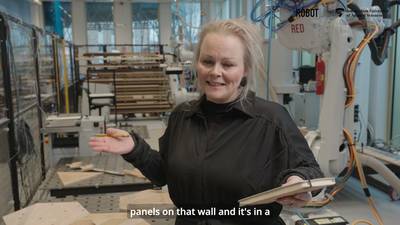Eindrapportage Smart Industry Hub Noord Nederland
DOCUMENT

Uitwerking van het smart industry ecosysteem voor onderwijs en arbeid. Hierin aandacht voor Smart Industry en Formeel leren, Leven Lang Leren, flexibilisering en Learning by doing.
DOCUMENT

Posterpresentatie gegeven tijdens bezoek SBE (Samenwerkende Bedrijven Eemsdelta) aan de Hanzehogeschool
DOCUMENT

How can a smart ‘upcycle wood factory’ (powered by industry 4.0 technologies and principles) help create meaningful and viable applications out of residual wood applicable to the hospitality sector?This video gives the answers.
YOUTUBE

In recent years, a step change has been seen in the rate of adoption of Industry 4.0 technologies by manufacturers and industrial organizations alike. This article discusses the current state of the art in the adoption of Industry 4.0 technologies within the construction industry. Increasing complexity in onsite construction projects coupled with the need for higher productivity is leading to increased interest in the potential use of Industry 4.0 technologies. This article discusses the relevance of the following key Industry 4.0 technologies to construction: data analytics and artificial intelligence, robotics and automation, building information management, sensors and wearables, digital twin, and industrial connectivity. Industrial connectivity is a key aspect as it ensures that all Industry 4.0 technologies are interconnected allowing the full benefits to be realized. This article also presents a research agenda for the adoption of Industry 4.0 technologies within the construction sector, a three-phase use of intelligent assets from the point of manufacture up to after build, and a four-staged R&D process for the implementation of smart wearables in a digital enhanced construction site.
DOCUMENT

An interview with HU researcher Beverly Pasian on smart cities, projects and urban life.
LINK
Contribution to conference magazine https://husite.nl/ssc2017/ Conference ‘Smart Sustainable Cities 2017 – Viable Solutions’ The conference ‘Smart Sustainable Cities 2017 – Viable Solutions’ was held on 14 June 2017 in Utrecht, the Netherlands. Over 250 participants from all over Europe attended the conference.
DOCUMENT

From the list of content: " Smart sustainable cities & higher education, Essence: what, why & how? Developing learning materials together; The blended learning environment; Teaching on entrepreneurship; Utrecht municipality as a client; International results; Studentexperiences; International relations; City projects in Turku, Alcoy and Utrecht ".
DOCUMENT

Design educators and industry partners are critical knowledge managers and co-drivers of change, and design graduate and post-graduate students can act as catalysts for new ideas, energy, and perspectives. In this article, we will explore how design advances industry development through the lens of a longitudinal inquiry into activities carried out as part of a Dutch design faculty-industry collaboration. We analyze seventy-five (75) Master of Science (MSc) thesis outcomes and seven (7) Doctorate (PhD) thesis outcomes (five in progress) to identify ways that design activities have influenced advances in the Dutch aviation industry over time. Based on these findings, we then introduce an Industry Design Framework, which organizes the industry/design relationship as a three-layered system. This novel approach to engaging industry in design research and design education has immediate practical value and theoretical significance, both in the present and for future research. https://doi.org/10.1016/j.sheji.2019.07.003 LinkedIn: https://www.linkedin.com/in/christine-de-lille-8039372/
MULTIFILE

In het dagelijks taalgebruik is ‘2.0’ een vage kreet geworden die ‘vernieuwing’ aanduidt: Paus Franciscus creëert een ‘Vaticaan 2.0’ en een dokter met internet is een ‘huisarts 2.0’. Nieuw en verbeterd! Maar wat moeten we ons dan bij 4.0 voorstellen? Nóg nieuwer? Nóg beter?
LINK